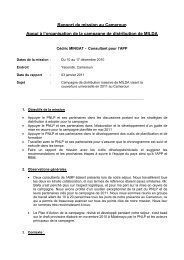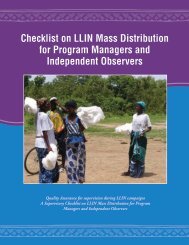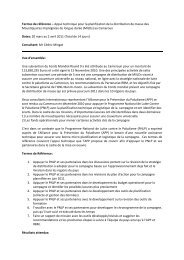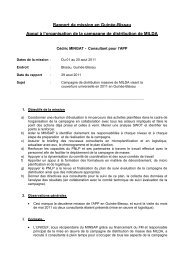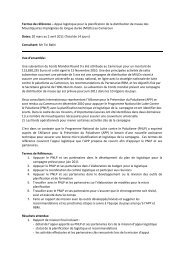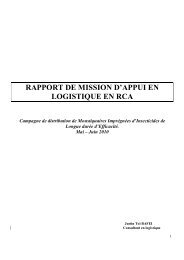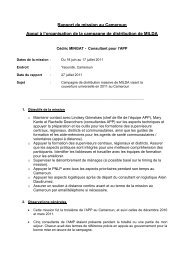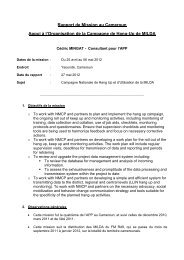- Page 1 and 2:
SPOT ONMALARIAA Guide toAdapting, D
- Page 3 and 4:
ACKNOWLEDGMENTSThis Guide is adapte
- Page 6 and 7:
CONTENTSOVERVIEWSpotlight on malari
- Page 8 and 9:
ABBREVIATIONSANCCIDADDDHSDFIDIMCIIP
- Page 10 and 11:
OVERVIEWSPOTLIGHT ON MALARIAEach ye
- Page 12 and 13:
OVERVIEWWHEN ARE RADIO SPOTS NOT US
- Page 14 and 15:
OVERVIEWGathering information perio
- Page 16 and 17:
STEP 1GATHER INFORMATION,BUILD YOUR
- Page 18 and 19:
STEP 1: GATHER INFORMATION, BUILD Y
- Page 20 and 21:
STEP 1: GATHER INFORMATION, BUILD Y
- Page 22 and 23:
STEP 1: GATHER INFORMATION, BUILD Y
- Page 24 and 25:
STEP 1: GATHER INFORMATION, BUILD Y
- Page 26 and 27:
STEP 1: GATHER INFORMATION, BUILD Y
- Page 28 and 29:
STEP 2DEVELOP THE CREATIVE BRIEFADA
- Page 30 and 31:
STEP 2: DEVELOP THE CREATIVE BRIEFO
- Page 32 and 33:
STEP 2: DEVELOP THE CREATIVE BRIEFU
- Page 34 and 35:
STEP 2: DEVELOP THE CREATIVE BRIEFR
- Page 36 and 37:
STEP 2: DEVELOP THE CREATIVE BRIEFB
- Page 38 and 39:
STEP 2: DEVELOP THE CREATIVE BRIEFO
- Page 40 and 41:
STEP 2: DEVELOP THE CREATIVE BRIEFS
- Page 42 and 43:
STEP 3ADAPT OR DEVELOPEFFECTIVE SPO
- Page 44 and 45:
STEP 3: ADAPT OR DEVELOP EFFECTIVE
- Page 46 and 47:
STEP 3: ADAPT OR DEVELOP EFFECTIVE
- Page 48 and 49:
STEP 3: ADAPT OR DEVELOP EFFECTIVE
- Page 50 and 51:
STEP 3: ADAPT OR DEVELOP EFFECTIVE
- Page 52 and 53:
STEP 3: ADAPT OR DEVELOP EFFECTIVE
- Page 54 and 55:
STEP 3: ADAPT OR DEVELOP EFFECTIVE
- Page 56 and 57:
STEP 3: ADAPT OR DEVELOP EFFECTIVE
- Page 58 and 59:
STEP 3: ADAPT OR DEVELOP EFFECTIVE
- Page 60 and 61:
STEP 4PRETESTPRETESTING: THE KEY TO
- Page 62 and 63:
STEP 4: PRETEST• Persuasion: Does
- Page 64 and 65:
STEP 4: PRETESTPattern for Four Gro
- Page 66 and 67:
STEP 4: PRETESTWho should conduct t
- Page 68 and 69:
STEP 4: PRETEST• The left-hand co
- Page 70 and 71:
STEP 4: PRETESTSample revisions bas
- Page 72 and 73:
STEP 5PRE-PRODUCTION, PRODUCTIONAND
- Page 74 and 75:
STEP 5: PRE-PRODUCTION, PRODUCTION
- Page 76 and 77:
STEP 5: PRE-PRODUCTION, PRODUCTION
- Page 78 and 79:
STEP 6BROADCAST YOUR SPOTS- Targeti
- Page 80 and 81:
STEP 6: BROADCAST YOUR SPOTS• If
- Page 82 and 83:
STEP 6: BROADCAST YOUR SPOTSREACHIN
- Page 84 and 85:
STEP 6: BROADCAST YOUR SPOTScertain
- Page 86 and 87:
STEP 7MONITOR, EVALUATE ANDREVISE Y
- Page 88 and 89:
STEP 7: MONITOR, EVALUATE AND REVIS
- Page 90 and 91:
STEP 7: MONITOR, EVALUATE AND REVIS
- Page 92 and 93:
ANNEXES- Annex 1:Resources (pages 9
- Page 94 and 95:
ANNEX 1RESOURCESINTRODUCTION TO MAL
- Page 96 and 97:
ANNEX 1: RESOURCESFor the unborn in
- Page 98 and 99:
ANNEX 1: RESOURCESHow radio complem
- Page 100 and 101:
ANNEX 1: RESOURCESThis communicatio
- Page 102 and 103: ANNEX 1: RESOURCESCommunication/mat
- Page 104 and 105: ANNEX 2TOOLS YOU CAN USETOPICSWorks
- Page 106 and 107: Seven-step radio spot production cy
- Page 108 and 109: Creative brief templateProject:Cont
- Page 110 and 111: Assessing radio spots for pretestWo
- Page 112 and 113: Sample pretesting guide for group d
- Page 114 and 115: Sample pretesting guide for group d
- Page 116 and 117: Sample pretesting guide for group d
- Page 118 and 119: Sample pretesting guide for group d
- Page 120 and 121: Tips for facilitating group discuss
- Page 122 and 123: Notetaking sheet: Radio spot pretes
- Page 124 and 125: Who listens and whenRadio station:L
- Page 126 and 127: Radio spot monitoring: A planning w
- Page 128 and 129: Radio spot evaluation: A planning w
- Page 130 and 131: Malaria communication activities pl
- Page 132 and 133: ANNEX 3SAMPLE SCRIPTS FOR SPOTSTOPI
- Page 134 and 135: ANNEX 3: SAMPLE SCRIPTS FOR SPOTSTi
- Page 136 and 137: ANNEX 3: SAMPLE SCRIPTS FOR SPOTSTi
- Page 138 and 139: ANNEX 3: SAMPLE SCRIPTS FOR SPOTSTi
- Page 140 and 141: ANNEX 3: SAMPLE SCRIPTS FOR SPOTSTi
- Page 142 and 143: ANNEX 3: SAMPLE SCRIPTS FOR SPOTSTi
- Page 144 and 145: ANNEX 3: SAMPLE SCRIPTS FOR SPOTSTi
- Page 146 and 147: ANNEX 3: SAMPLE SCRIPTS FOR SPOTSTi
- Page 148 and 149: ANNEX 3: SAMPLE SCRIPTS FOR SPOTSTi
- Page 150 and 151: ANNEX 4: GLOSSARYRadio spot: A shor
- Page 154: CHANGE ProjectAcademy for Education




